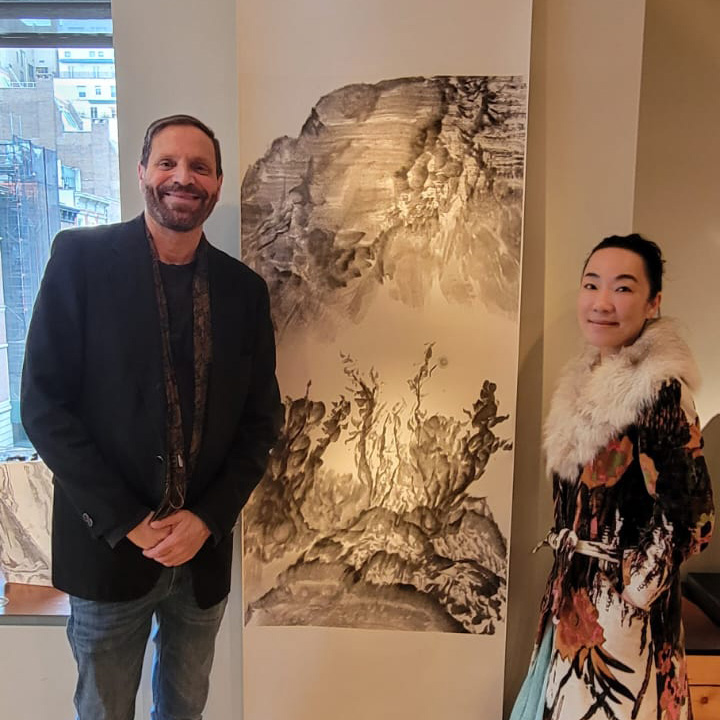Meditating in the Artworld of Bingyi 冥想在冰逸的艺术世界中

*Click for a version in Mandarin
“Lack of certainty is the moment of poetics.” Bingyi


Bingyi’s creative process is about seeing—to see, in the same paper, the same ink, the vision of what there is again and again. It is to confront the vision in the heart multiple times until it becomes irresistible and you have to paint it down. The genre of ink painting is based on the metaphysics that everything about the world can be expressed in all colors between the deepest dark and the cleanest white. It is the language that reveals not the clothing but the soul of this world.
For Bingyi, her work is not about describing, analyzing, or representing something else—it is about being, and being nature itself. It is said that during the evolution of primates, their survival skill was crucially based upon the ability to visually anticipate the distance between each tree in a forest. Hence vision was the start of the development of our sense perception, and for that reason, vision is our most prominent sense of all back in nature. Is there anything about Bingyi’s painting that she is trying to convey, that is, to restore our most primitive ability to see what there is? “Always, look at life in the face,” Virginia Woolf once said. “The truth does not lie in what you want to see, but in what it is,” said Bertrand Russell in his last interview. Such a natural capacity that was intrinsically linked with our connection to nature has been weakened during our presence in an increasingly artificial world, in our daily navigation of society, politics, our self and others. In such a man-made world we begin to take too many things for granted, and to cultivate the Aristotelian sense of our second nature. As a result we are alienated from who we are in the most natural state, and gradually lose our natural capacity for pity and love as expressed by Rousseau. Meditating in the artworld of Bingyi is to return to the state of nature while recollecting our most primitive ability to see what there is. Big as a wave, small as a flower petal, or something like a pond which surface is being blown upon by the wind and touched by a leaf—no, it is not just the substantial world that Bingyi is trying to see. Beyond the realm of the substantial, there is the realm of Forms, the ideal that comes prior to any materialistic features of the ink and paper. It is from this Form and order that we have such an extension of the materialistic realm that we can touch and see, and the Form is what gives energy, what enlightens its shadows. This Form that Bingyi’s painting strives to capture is by nature, beautiful.

The piece entitled “Peach Blossom Spring” had its name from a traditional Chinese poem written by the great Song Dynasty poet T’ao Ch’ien. In the land of the Peach Blossom, it is been discovered such a utopia where everyone lives in peace and with contentment. Without any awareness of wars and conflicts going on in the outside world, people farm, weave silk, and raise livestock with perfect gratitude for what they have. It is a space that comes from the imagination, an ideal that has been created and recreated in many versions and by many artists across time and space. Yet Bingyi’s representation of peace has an energy that is coming out of it, a state of peace that is more than simple plainness: in the middle of Bingyi’s piece you see this joining of forces that can be either waves or petals, or maybe a flower that is struggling with all its force to bloom: it is the energy of spring that is invigorating the start of a new year, the light that shines and waits to be absorbed into all forms of life. “There are times,” said Bingyi, “when I happened to stop from what I was doing and came back losing the vision that I originally had in mind. Then I had to start all over again to re-grasp the essence of what had been seen.” It is through these constant repetitions, imaginations and re-imaginations that such a vision can be grasped more clearly and distinctly. Bingyi feels responsible to communicate what nature has transcended to her to the audience through the medium of ink and paper in the most lucid entirety.

This energy, this force, this waving tide of thought is so overwhelming that in the middle she captured this delicate moment of the joining of sides: a merge of lines and colors along with countless details of splashing water. They join in silence. They mute just like every minute struggle that we have to deal with in everyday life. Hence the whole picture can stretch with a sense of relief. It is the moment that was before something big was about to begin, the moment that everything is prepared but nothing has happened yet——this is, Bingyi thinks, the moment that conceals the most energy in nature.

Known for her giant-scale ink paintings, Bingyi has brought to New York this year a new sixty-five feet long scroll entitled “Apocalypse.” Four years and a half were spent on this single work, although that time is less than a half of some of her more gigantic projects: “I knew it was going to work. Even though it took me twelve years,” she said. “Some people work on a project for a few months and stop. But I know it was going to work once I am on it. Art is such a thing that, once you have it, you will never lose it. So it doesn’t really matter how much time you’ll spend on it because you know that you are already there.” A macroscopic world, however, contains a milliard of details: in the scroll there is the tree, the mountain, the Buddha, etc. “To see a world in a grain of sand, and a heaven in a wildflower. Hold infinity in the palm of your hand, and eternity in an hour” wrote William Blake in England two hundred years ago. Yet Bingyi’s work strives to convey both the small and the large, the minimal and the gigantic, the most trivial and the most tremendous, together in the same work. It is from Hegel’s dialectic vision of history that we started to view ideas being divided into thesis and antithesis, and from Saïd’s critique of Orientalism we began to categorize culture through an east-west dichotomy. In the work of Bingyi there is no such thing as a dichotomy; no such thing as the inability for conflicting ideas to coexist. Every being, every existence, every relation is summoned together in this one piece of scroll. All beings are related in such a way that one is not what it is without the other. It is like when Leibniz wrote in his metaphysics that in every single substance one can see the image of God, the order of the entire universe, and every single substance is connected with each other, amounting to the unity of the world we inhabit. Such is the artworld of Bingyi. It is the movement to reveal the truth of nature that had been long concealed by the world of mankind, yet the paintings try to rediscover this innate interconnectivity, the mobility and mutual reliance between the human world and the world of nature, where we belong to from the very start to the end of time.

冥想在冰逸的艺术世界中

“缺失的确定性正是诗意的时刻。” 冰逸

冰遗的创作过程是关于看见——在同一张纸、同一种墨水中,一次又一次地看见这里究竟有什么。这个过程是去多次面对心中的愿景,直到它变得不可抗拒,直到你必须把它画下来。水墨画这一体裁基于这样一种形而上学:世界的一切都可以用最深的黑色和最干净的白色之间的所有颜色来表达。水墨是一种尝试表达这个世界的灵魂而非这个世界的衣服的语言。
对于冰逸来说,她的作品不是去描述、分析或代表任何作品以外的东西,而是让作品存在,并成为自然本身。据说,在灵长类动物的进化过程中,它们的生存技能主要是基于对森林中每棵树之间的距离进行视觉预测的能力。因此,视觉是我们感官知觉发展的开始,也正因为如此,视觉是我们在回到自然界时最突出的感官。冰逸的画是否是在尝试让我们重拾自己最原始的,去看见的能力?”永远,正视生活,”弗吉尼亚·伍尔夫说。”真理不在于你想看什么,而在于它是什么,”伯特兰·罗素在他最后一次采访中说。看见,这样一种使我们与自然产生内在连接的能力,在我们置身于一个越来越人工化的世界,和日常对于对社会、政治、自我和他人的审视中被削弱。在这样一个人造的世界里,我们开始认为许多事情是理所当然的,并且养成了亚里士多德所提出的“第二天性”。我们与最自然状态下的自己疏远了,并逐渐失去了卢梭所表达的怜悯和爱的能力。在冰逸的艺术世界中进行冥想,就是要回到自然状态,重拾我们最原始的能力,看清这里究竟有什么。大到一朵浪花,小到一片花瓣,或者像一片被风吹过的池塘被一片叶子触及的时刻——不,冰逸想看到的不仅仅是实质性的世界。在具象化了的领域之外,还有形式的领域,那是先于纸和墨的任何物质性的理想型。正是从这个理想型中,我们有了一个可以看到和触摸的具体世界,而理念是赋予这个世界以能量,并且将它的影子照亮的灵感源头。冰逸的绘画所努力捕捉的这种理型,从其本质来说,就是美的。

这幅名为《桃花源》的作品的名字来自于宋代伟大诗人陶潜的一首中国传统诗词。在桃花源里,人们发现了这样一个乌托邦,每个人都生活在和平与满足中。人们完全不了解外界发生的战争和冲突。他们耕种、编织丝绸、饲养牲畜,并对他们所拥有的一切充满感激。这是一个源于想象的空间,一个被许多来自不同时间和空间的艺术家,以各种版本创造和重新创造的理想。然而,冰逸对和平这一概念的表现有一种内在的能量,她的和平不仅仅是简单的平淡:在冰逸的作品中,你可以看到种种力量的结合,它们可以被具象为波浪,花瓣,也可能是一朵正在全力挣扎绽放的花:这是春天的能量,正在为新一年的开始注入活力,这是一束闪耀的光芒正在等待着被所有形式的生命吸收。“有些时候,”冰逸说,”当我偶然从我正在画的画中停下来,再回去的时候,我会失去我原来心中的愿景。这时我不得不重新开始,重新掌握所看到的东西的本质。”正是通过这些不断的重复、想象和再想象,这样的愿景才能被更清楚、更明确地把握住。冰逸觉得自己有责任将自然界传递给她的东西通过水墨和纸张的媒介,最清晰和完整地传达给观众。

这种能量,这种力量,这种思想的浪潮是如此的势不可挡,以至于在画面中间她捕捉到了这种多方力量结合的微妙时刻:线条和颜色的融合,以及无数的水花飞溅的细节。它们在沉默中结合。它们静默着,就像我们在日常生活中必须处理的每一分钟的斗争。因此,整个画面延伸出一种解脱的感觉。这是一件大事即将开始之前的时刻,是一切都准备好了但还没有发生的时刻——冰逸认为,这是自然界中隐藏着最多能量的时刻。

以巨型水墨画著称的冰心,今年在纽约带来了一幅题为 “万物之始 “的65英尺长的新画卷。这幅作品花了四年半的时间,尽管这个时间还不到她一些更巨大的项目所花费的一半。”我知道它将会成功。尽管它花了我十二年时间,”她说。”有些人在一个项目上工作了几个月就停止了。但我知道,一旦我开始工作,它就会成功。艺术是这样一种东西,一旦你拥有它,你将永远不会失去它。因此,你会花多少时间在上面其实并不重要,因为你知道你已经抵达那里了。” 这样一个宏观的世界里包含了无数的细节:在画卷中,有树,有山,有佛,等等。”《佛典》中说,一花一世界,一叶一菩提。威廉·布莱克在两百年前的英国写道:“在一粒沙中看到一个世界,在一朵野花中看到一个天堂。在你的手掌中握住无限,在一小时内握住永恒。” 冰逸的作品力图在同一作品中同时传达微观的和宏观的,最微不足道的和最庞然重硕的。从黑格尔的辩证历史观中,我们开始将思想分为论题和对立面,从萨义德的东方主义批判中,我们开始使用东西方的二分法对文化进行分类。在冰逸的作品中,没有所谓的二分法;没有所谓的相互冲突的思想无法共存的问题。每一种存在,每一种存在,每一种关系都被召集到这幅画卷中。所有的生命都以这样一种方式联系在一起,即一样事物离开了另一样事物就不再是它本身。这就像莱布尼茨在他的形而上学中写道,从每一个物质中我们都可以看到上帝的形象,整个宇宙的秩序以及每一件单独的物质都是相互联系的,这就是我们所居住的世界的统一性。这就是冰逸的艺术世界。这是一项去揭示被人类世界长期掩盖的自然真相的运动,同时这些画作试图重新发现这两种世界之间与生俱来的相互连结,人类世界和自然世界之间的流动性和相互依赖性。这是我们从一开始就归属于的地方,直到时间的尽头。


Bingyi with AMM Publisher Reiss
冰逸 和 李泽辰







